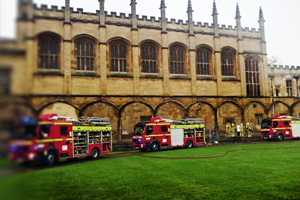FläktGroup and the Magic of Smoke Extract
Fire in historic buildings can cause significant damage and loss of irreplaceable artefacts that no level of wizardry can fix or restore.

Fire in historic buildings can cause significant damage and loss of irreplaceable artefacts that no level of wizardry can fix or restore.

However, when the correct management procedures and equipment are in place such as was the case when fire struck the set of Hogwarts’ Great Hall in November; where the fast response of Christ Church College staff and the fire brigade used smoke extraction fans to bring the fire in The Great Hall under control, with no injury or significant damage to the building. This allowed the best possible outcome to be delivered in the circumstances.
Where the attending brigade provides the smoke extraction, the use of an extract fan is clear, but for in situ equipment the case is rarely so clear-cut:
Traditionally, separate smoke extract fans would be installed alongside the day-to-day ventilation fans, with the smoke control fans only being used in an emergency. This situation, however, presents a problem, as smoke extract fans can represent a sizeable investment for property owners. If these fans could also be operated to provide day-to-day ventilation, within a “dual mode” system, this would significantly increase the return on investment.
Depending on the application, running smoke control fans which also provide general ventilation is often the most cost-effective option, as long term running cost savings are likely to far outweigh the initial investment, which is why, in recent years, there has been a greater prevalence of dual purpose (dual mode) fan units. On an everyday basis these fans exhaust stale air from a space allowing fresh or treated air to be provided into the space, thereby improving the indoor air quality, whilst also providing smoke extract in an emergency scenario. This solution has grown in popularity for a number of reasons, not least, due to the fact that it delivers reduced installation and maintenance costs.
When designing a “dual mode” system it should be noted that the required air exhaust rate is usually 25-50 % lower than that needed to extract hot smoke in the event of an emergency. As fans are used more regularly for day-to-day use, they must be designed and manufactured in accordance with Fan ErP Regulation 327/2011, and where appropriate, Motor Regulation 640/2009.
On the other hand, fans designed for dedicated smoke extract are exempt from meeting the efficiency requirements laid out in the Eco-design Directive (as they are only used under emergency conditions or when the system is being tested). Fans used for dual mode operation are however not exempt, and consequently need to comply with strict energy efficiency targets.
Although Fläkt Woods fan products already offer high efficiency levels, these can be further enhanced by operating fans via a frequency inverter drive, which allows for precise control of supply and exhaust air rates to balance the building’s ventilation needs. Inverters may also be used to operate the smoke extract fans at different duty points if they serve multiple zones in the event of a fire.
When running a smoke extract fan via a variable frequency drive there are some key points which need to be addressed; in order to mitigate against the potentially harmful effects of a synthesised waveform from an inverter, fans should be certified for emergency high temperature use under EN12101-3 for one or more of the following conditions:
- Direct feed; in which case an inverter must be by-passed and the fan is connected direct on line for emergency operation.
- Converter feed (Inverter); where a fan certified for direct feed is connected to an inverter via a waveform filter. Note that filters can result in reduced voltage at the motor terminals and may require motor de-rates of up to 20%.
- Converter feed (Inverter); where the fan has been tested when directly connected to an inverter.
The simplest and sometimes the most appropriate solution is to run fans Direct On Line (the “Direct Feed” option); bypassing the inverter used for day-to-day operation, however this may then require further management of the fire strategy to ensure that smoke extraction rates to specific zones meet the required design criteria. For this reason, using inverter control in some circumstances, where precise control is needed in a fire scenario, may in fact be a better solution.
Today, the norm is often for axial fans to be designed for both general and smoke control modes. Unfortunately, however, there is a big gap in market knowledge about the issues that can arise when using an inverter while a fan is in smoke mode, potentially resulting in non-compliance and in extreme cases endangering life and property in the event of a fire.
Fläkt Woods is a leading manufacturer of ventilation and air movement products, including fire safety solutions. Its HT JMv Aerofoil axial fan delivers aerodynamic efficiencies up to 84 %, while offering a smoke extraction operation mode (400°C for two hours, certified in accordance with EN12101-3).
As far as use of inverters (also known as Frequency Converters, VFDs or VSDs) is concerned, GAMBICA and The Smoke Control Association offer specific guidance related to their use, which Contractors and Installers should also be following when installing HT Fans controlled by Inverters.
Get in touch today, to see the solutions we can conjure up for you.
http://www.flaktwoods.com/contacts/
Photo credit: Oxfordshire Fire and Rescue